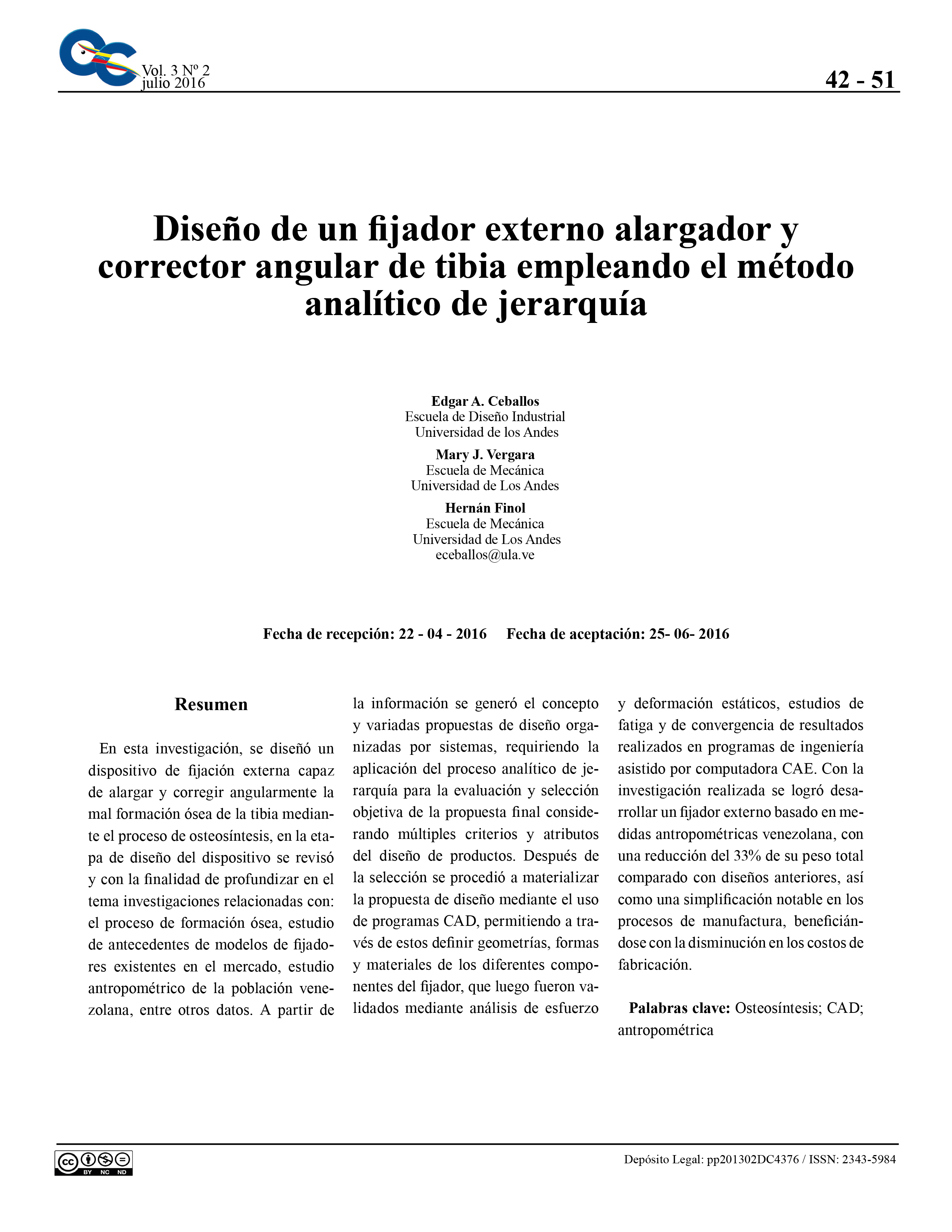Design of an external fixator, extension and angular corrector of tibia using the analytical method of hierarchy
Keywords:
Osteosynthesis, CAD Programs, anthropometricAbstract
In this research, an external fixation device was designed, capable of lengthening and angularly correcting the bad bone formation of the tibia through the process of osteosynthesis. In the design stage of the device, research related to: the process of bone formation, study of the background of existing fixator models in the market, anthropometric study of the Venezuelan population, among other data, was reviewed. From the information, the concept and various design proposals organized by systems were generated, requiring the application of the analytical process of hierarchy for the evaluation and objective selection of the final proposal considering multiple criteria and attributes of the product design. After the selection, the design proposal was materialized through the use of CAD programs, allowing through these programs to define geometries, shapes and materials of the different components of the fixture, which were then validated through static stress and deformation analysis, fatigue studies and convergence of results carried out in CAE computer-assisted engineering programs. With the research carried out, it was possible to develop an external fixator based on Venezuelan anthropometric measurements, with a 33% reduction in its total weight compared to previous designs, as well as a notable simplification in the manufacturing processes, benefiting from the decrease in manufacturing costs.
Downloads
References
De Pablos Juan. 2008. Deformidades Angulares de las EEII en la Edad Infantil y Adolescencia. Universidad de Navarra. Pamplona, Colombia.
Sánchez P., Yamhure F., Satizabal F., Calderón O., Rodríguez N., y Salazar W. (2005). Osteotomía femoral proximal percutánea con fijador externo. Ortopedia Infantil, Volumen19, N°3.
Saaty Thomas. (1998). Método Analítico de Jerarquía (AHP); Principios Básicos. EN: Evaluación y Decisión Multicriterio. Reflexiones y Experiencias. Editado por Eduardo Martínez y Mauricio Escudey. Editorial Universidad de Santiago. Pp 17-46.
Aguayo F., y Soltero V. 2003. Metodología del Diseño Industrial: Un enfoque desde la ingeniería concurrente. RA-MA, Madrid, España.
Fundación Centro de Estudios Sobre Crecimiento y Desarrollo de la Población Venezolana (FUNDACREDESA). (1993). Tablas de pesos, tallas, longitudes óseas venezolanas, Caracas.
Ilizarov G. A., Bianchi M. y González M. 1989. OSTEOSINTESIS. Técnicas de Ilizarov. Ediciones Norma. España.
Fazal A., Saleh M. ( 2001). Treatment of distal femoral nonunion by external fixation with simultaneous length and alignment correction. Injury, Int. J. Care Injured 33, 127.
Carbonell P., Valero J., Fernandez D., y Franqueira J. (2007). Monolateral external fixation for the progressive correction of neurological spastic knee flexion contracture in children. Strat Traum Limb Recon, 2:91–97 DOI 10.1007/s11751-007-0026-4.
Krischak a, Augat, Beck, Arand M. Baier B., y Blakytny. (2006). Biomechanical comparison of two side plate fixation techniques in an unstable intertrochanteric osteotomy model.
Mohammed R., Abdul-Kadira y Ulrich Hansena. (2007). Finite element modelling of primary hip stem stability: The effect of interference fit. Journal of Biomechanics 41 (2008) 587–594.
iehoff A. (2004). Adaptation of mechanical, morphological, and biomechanical properties of rat growth plate to dose-dependent voluntary exercise. Bone35, 899– 908.
Lochmuller E., Groll O., Kuhn V. y Eckstein F. (2002). Mechanical strength of the proximal femur as predicted from geometric and densitometric bone properties at the lower limb versus the distal radius. Bone Vol. 30, No 1. January 2002:207-216.
Shigley J. y Mischke. 2002. Diseño Ingeniería mecánica. 6taEdición, Mc Graw-Hill, México.

Downloads
Published
How to Cite
Issue
Section
License

This work is licensed under a Creative Commons Attribution-NoDerivatives 4.0 International License.







